According to WHO reports, every day about 1 million people acquire STIs - sexually transmitted infections. Symptoms in women may be subtle and subtle. An alarm signal for contacting a doctor is the identification of specific symptoms in a woman: uncharacteristic discharge, discomfort and pain during sex, redness and rashes on the skin in the genital area, perineum or anus, itching, frequent urge to urinate, swelling of the inguinal lymph nodes. The most commonly diagnosed female genital infections are: urogenital herpes, syphilis, trichomoniasis, chlamydia, gonorrhea.
Infection and incubation period of sexually transmitted diseases
Sexual transmission is the dominant route when it comes to sexually transmitted diseases.
However, it is important to be aware of other situations in which infection may occur.
- Contact-household transmission can occur in the case of all viral infections, trichomoniasis, as well as scabies and phthiriasis.
- Vertical - infection occurs along the mother-child line during pregnancy or at the time of childbirth. This path is not excluded for HPV, syphilis, gonorrhea, HIV, candidiasis, etc.
- The parenteral route is associated with infection through blood transfusions and injections of narcotic substances. HIV and hepatitis B can be transmitted this way.
Intimate infections in ancient cultures of India and China: information is vague
Little can be said about venereal diseases in Indian culture, although they were certainly part of urban culture. The oldest sacred books, the Vedas and Atharva Vedas, contained some information about venereal diseases, aphrodisiacs and the treatment of sexual disorders, but they were not scientific treatises. More important is the later Ayurvedic knowledge, which has not changed that much over time. In the works of classical Ayurvedic medicine, genital diseases and discharges, methods of treatment and even surgery were mentioned.
In ancient Chinese medicine there is not much information about sexually transmitted diseases, but there is a description of gonorrhea and syphilis (which was treated with mercury ointment).
Oddly enough, ancient doctors rarely recognized sexual contact as a cause of intimate infections. This may have been due to shame, the patient's fear of the doctor, long incubation periods for venereal diseases and, of course, the erroneous theory of miasms.
Some authors who have studied the sex lives of ancient cultures believe that syphilis existed in Rome and other parts of the world even before the beginning of the Middle Ages (given prostitution, erotic literature and the promiscuity of many emperors). But other medical historians refute this concept.

"Sexually transmitted diseases." Drawing by Felicien Rops
Incubation period of sexually transmitted diseases in women
The incubation period is the period of time when the bacterium has already entered the body, but does not yet manifest itself clinically.
Since the group of pathogens of sexually transmitted infections is very large, the question of when symptoms of sexually transmitted diseases appear in women must be answered in relation to each specific microorganism.
Some sexually transmitted diseases have a more precise incubation period.
For syphilis it is 3 weeks, gonorrhea – 4 weeks, trichomoniasis – 7 days.
Viral pathology has more blurred boundaries: from several weeks to 2-3 years.

How do sexually transmitted diseases manifest in women?
Despite the variety of symptoms and characteristics of each specific pathogen, a number of common manifestations can be identified that are characteristic of many sexually transmitted diseases.
Discharge from the genital tract is one of the main symptoms of sexually transmitted diseases in women.
Almost all pathogens of sexually transmitted infections change the nature of vaginal secretions.
A curd-like discharge with a bright white color is characteristic of a fungal infection.
Gonorrhea and trichomoniasis most often manifest as profuse, foamy leucorrhoea, which has a milky yellow color, a thick creamy consistency and an unpleasant odor.

Discharges from chlamydia, urea and mycoplasmosis do not have any striking features.
However, many women note an abundance of leucorrhoea and a change in color to a more yellowish color.
Viral infections rarely change the nature of vaginal secretions.
Pain is a common symptom of sexually transmitted diseases in women.
The localization of pain will depend on the level of damage to the genitourinary system.
With the development of urethritis - during urination, with inflammation of the bladder and uterus - above the pubis in the center.
If the fallopian tubes and ovaries are affected, there will be pain on the right and left in the lower abdomen.
Acute inflammatory processes in gonorrhea and trichomoniasis may be accompanied by changes in general condition - fever, chills, nausea, lethargy and sleep disturbances.
Pain due to STIs intensifies during sexual activity, during bumpy driving, and sometimes even when walking.
But the pain is not always pronounced.
Many infections (chlamydia, mycoplasma) manifest themselves as aching, intermittent pain that does not cause significant discomfort.
Rash due to sexually transmitted diseases in women.
More often it occurs as a sign of viral pathology.
With a herpetic infection, the elements of the rash are represented by vesicles with serous, cloudy contents, which, when opened, turn into ulcers.
Rashes on the genitals with condylomatosis also have their differences.
They are localized on the mucous membranes of the genital tract, in the anus, and can appear on the inner thighs and groin.
The elements of the rash are flesh-colored or slightly pinkish in color, most often attached to the skin with a narrow stalk (less commonly, on a wide base).
The surface of the growths is lumpy; in the literature there is a comparison with cauliflower.
Condylomatous elements remain on the skin for a long time.
They may regress after antiviral treatment or be removed using mechanical methods (laser, radio wave).
A rash in the groin due to sexually transmitted diseases in women can be one of the manifestations of secondary syphilis.
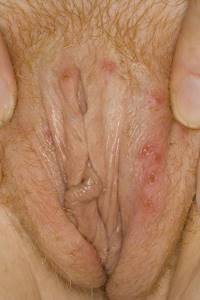
What type of rash occurs and when it appears depends on the general resistance of the body in a particular patient.
The weaker the immune system, the earlier the rashes will appear and the more abundant they will be.
- Enlargement of the inguinal lymph nodes is one of the signs of an acute venereal process. More typical for syphilis and inguinal granuloma.
- Itching of the genital organs is a symptom that occurs against the background of candidiasis, a herpetic infection.
- Dyspareunia is painful, uncomfortable sensations associated with sexual intercourse. This symptom can accompany many sexually transmitted diseases - herpes, condylomatosis, trichomoniasis, gonorrhea.
- Infertility. Although this condition is a complication of STIs, many patients consult a doctor for the first time with this complaint.
Common symptoms of sexually transmitted diseases in women
Diseases from the STI group are contagious. After an illness, a person’s immunity does not develop. This means that a person who has recovered from the disease can become infected with the same disease again and it is important to remember this!
The presence of specific symptoms of STDs in women:
- dryness and painful perception of sex;
- swelling of the inguinal lymph nodes (one or more);
- disturbances in the normal cyclicity of menstruation;
- any discharge from the anus;
- pain, irritation, itching in the perineum;
- any rash on the genitals;
- atypical vaginal discharge (green, leucorrhoea, foamy, smelly, bloody);
- frequent painful urge to urinate;
- swelling of the vulva.
The main route of transmission of STIs is direct sexual contact. You can also become infected through blood, in utero, and sometimes through household methods.
What are the first symptoms of sexually transmitted diseases in women?
There is no single pathognomonic sign by which one could immediately suspect the presence of a sexually transmitted disease.
Certain types of bacteria may not show themselves at all for a long time.
For example, ureaplasma, chlamydia and mycoplasma can persist in the genitourinary tract for more than one year.
However, you should always suspect a sexually transmitted disease if the following symptoms appear after sexual intercourse with an unreliable partner within 2-4 weeks.
These are discharge from the genital tract, any rashes, pain in the genital area and lower abdomen, problems with urination.
STIs among Jews: punishment for sins
The ancient Jews, of course, also had intimate infections, but there is not much information about this - mainly in religious texts, the Bible and the Talmud. They, of course, were not written by doctors, so modern researchers may find it difficult to correlate symptoms with specific diseases.
We know that the Jews interpreted intimate infections as God's wrath, punishment for sins and disobedience. Biblical texts contain references to male and female prostitution, treponematosis, and genital discharge that could be gonorrhea or chlamydial urethritis. In the latter case, the priests recommended avoiding sex for seven full days, and the dishes, clothes and bedding of the sick were considered “unclean.”
Religious texts describe many stories that are monstrous by today's standards - for example, Moses, who ordered the slaughter of 24,000 women taken into slavery after the war with the Midianites, and the victorious soldiers were placed in a 7-day quarantine. Modern scholars suggest that Job's skin disease was syphilis, and King Solomon, who had a whole harem, recommended in parables to “avoid harlots.”
Jewish medicine remained religiously oriented for quite a long time, and only under the influence of Hellenism did practicing physicians begin to appear.
Complications of sexually transmitted diseases in women
Possible complications of sexually transmitted infections are very numerous.
They can be divided into groups.
- From the urinary system: inflammation in the bladder, kidneys, cicatricial strictures of the urethra.
- Reproductive: infertility (female and male), impaired potency and libido.
- Adhesive processes in the pelvis.
- Joint damage.
- Eye diseases.
- Complications of pregnancy: miscarriage, stillbirth, congenital defects in the fetus.
Let's take a closer look at some sexually transmitted diseases.
Syphilis is one of the oldest pathologies, which, however, poses a great danger in our time due to the predominance of latent forms.
The disease is caused by Treponema pallidum (treponema pallidum).
The pathology is characterized by a 3-stage course.
Primary syphilis is the appearance at the site of introduction of bacteria of a specific formation - chancre.
As soon as the skin elements of the rash appear, secondary syphilis begins.
Tertiary is rare nowadays and is characterized by pathological changes in internal organs. Diagnosis of syphilis - direct dark-field microscopy and serological tests (RW, ELISA).
Treatment is based on the use of penicillin antibiotics.
Gonorrhea is a bacterial venereal infection caused by gram-negative diplococcus.
The disease has a clear clinical picture - creamy, copious discharge with an unpleasant odor.
The mucous membrane of the genital tract and urethra is damaged.
All research methods are used in diagnosis: microscopy, culture, serology and PCR.
Treatment is carried out with antibacterial drugs - azithromycin, ceftriaxone, etc.
Trichomoniasis is a common disease caused by the bacterium of the same name (Trichomonas vaginalis).
Clinically manifested by specific discharge from the genital tract - copious, foamy, milky or yellowish.
Itching is also a concern.
Diagnosing fresh trichomoniasis is quite simple - the bacteria are clearly identified by simple microscopy.
Treatment is carried out with drugs from the metronidazole group.
Herpetic infection is a viral disease caused by HSV type 2.
It is characterized by the appearance of multiple blistering rashes on the skin and mucous membranes of the genital organs, accompanied by itching and pain.
The diagnosis is made according to a characteristic clinical picture, supplemented by PCR analysis and serology.
Treatment is antiviral drugs containing acyclovir.
Chlamydia is a common pathology caused by Chlamydia trachomatis.
In some cases, the course is asymptomatic; there may be minor nagging pain in the lower abdomen and milky discharge from the genital tract.
The best diagnostic method is PCR.
Treatment is carried out with antibacterial agents - azithromycin, josamycin, etc.
Ureaplasmosis and mycoplasmosis are diseases with similar symptoms, caused by different subspecies of bacteria of the mycoplasma family.
In 60% of cases, the disease is asymptomatic.
It is found in patients undergoing preventive diagnostics, for example, at the stage of pregnancy planning.
Ureaplasmas in small titers do not lead to the development of the disease and are considered conditional pathogens.
The danger of these diseases is the formation of adhesions around the ovaries and tubes, which subsequently leads to infertility and increases the risk of ectopic pregnancy.
The best diagnostic method is PCR analysis.
Treatment is carried out with antibacterial drugs with the obligatory subsequent restoration of the vaginal microflora.
Symptoms of certain sexually transmitted diseases
- Syphilis
The first sign of infection is the appearance of a cartilaginous compaction on the mucous membrane or skin.
A red, painless, ulcerative formation subsequently forms on its surface, covered with a grayish coating on top.
If plaque does not completely cover the formation, then a red rim forms around it.
The formation is called “chancroid”.
A month later, the ulcer disappears.
After some time, the body becomes covered with a finely spotted rash.
Papules and pustules may be present, which appear when the pathology becomes severe.
- Gonorrhea symptoms
The main symptom of gonorrhea in a man is urethritis.

In women, the pathology often becomes asymptomatic.
Manifestations of infection can be detected during examination by a doctor.
Discharge from acute gonorrhea is purulent in nature.
If left untreated, gonococcal infection can provoke the development of inflammation of the Bartholin gland.
As a result of blockage of its ducts, the resulting secretion accumulates in the cavity of the gland.
It suppurates with the formation of a cyst and the formation of an abscess.
A woman complains of painful cystic formation.
When examining the mucous membrane in the affected area, it is very hyperemic, and an increase in body temperature is also noted.
- Signs of trichomoniasis
The infection causes inflammation in the vagina.
What discharge indicates the presence of pathology?
The main sign of infection is a specific discharge: it is profuse, foamy, yellow-green in color, and accompanied by the smell of rotten meat.
Due to the release of enzymes (proteases), Trichomonas are capable of deep penetration into the mucous membrane.
By dissolving it, microorganisms injure microcapillaries.
During the examination, the doctor sees these areas of hemorrhage.
When examining the cervix in the speculum, it is severely hyperemic and strewn with hemorrhages.
Externally it resembles a strawberry.
- Chlamydia clinic
Symptoms of infection may be absent or mild.
Chlamydial infection most often affects the cervix.
Pathology can provoke very dangerous complications that lead to infertility.
The development of salpingoophoritis is manifested by the presence of cramping pain and bleeding.
As a result of the purulent process occurring in the tubes, adhesions develop that prevent the passage of the egg and the onset of fertilization.
If fertilization does occur, then as a result of tubal obstruction, the egg will not be able to penetrate the uterine cavity, which will provoke the development of an ectopic pregnancy.
The infection can also lead to the formation of adhesions in the uterine cavity.
- Symptoms of genital herpes
The main symptom that appears when infected with genital herpes is the formation of a watery rash.
The disease begins acutely, the patient complains of weakness, malaise, infection is accompanied by an increase in temperature.
The formation of rashes is preceded by a prodromal period.
There is discomfort at the site of the rash.
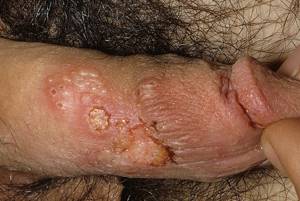
If left untreated, the disease becomes chronic.
Periods of exacerbations are followed by periods of remission.
Once the infection penetrates the body, it settles there forever.
- How do myco- and ureaplasmas manifest themselves?
Infection with urea and mycoplasma infections may go unnoticed.
In some cases, manifestations of infection are limited to symptoms of urethritis, in which clear discharge appears and itching is present.
Infection poses a threat during pregnancy, increasing the risk of spontaneous abortion or premature birth.
Blood tests for sexually transmitted diseases in women
If a sexually transmitted infection is suspected, one of the examinations prescribed is a blood test to determine antibodies.
Antibodies are protein structures produced in a living body in response to any bacteria or virus entering the blood.
Within two weeks after infection, immunoglobulins M appear, the concentration of which in the blood gradually decreases and eventually tends to zero.
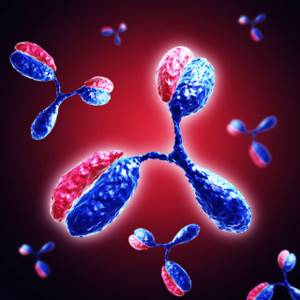
Occurring at a later date are immunoglobulins G.
The time of their appearance may vary depending on the type of pathogen.
Ig G, when detected in the blood, can indicate how long ago the infectious process is (its chronic course) or an infection that has already been suffered and treated.
These antibodies can remain in low titres until the end of life.
There are many types of tests to determine immunoglobulins.
ELISA, RIF and others are often prescribed.
Many potentially infected patients are interested in the question of when tests for sexually transmitted diseases in women are positive.
Considering the timing of the appearance of antibodies, it is necessary to understand that during the first two weeks from the moment of infection, tests can give a false negative result.
What are sexually transmitted diseases?
Sexually transmitted diseases are usually called venereal diseases in honor of the goddess of love, Venus. In medicine, another abbreviation is often used - STIs (predominantly sexually transmitted infections). It more specifically reflects possible methods of infection: diseases pass from person to person through sexual intercourse, but for some infections other options are possible.
In medicine, a separate area has been identified - venereology - a science that studies diseases that are transmitted through sexual intercourse. Doctors who carry out therapeutic measures against these diseases are usually called venereologists. These specialists treat pathologies of the reproductive system in both men and women.
How are sexually transmitted diseases transmitted?
As noted above, infection with a sexually transmitted disease occurs through unprotected sexual contact. Moreover, the method of intercourse often determines the particular form of pathology and the location of its manifestations. Transmission is possible through any type of contact, heterosexual and homosexual. The risk of infection increases sharply with group sexual intercourse and the absence of mechanical means of contraception.
It is worth noting that infection with a sexually transmitted disease can also occur outside of sexual contact. Infection occurs through close contact with a patient or carrier, sexual caresses involving the genitals, mouth, and rectum. The pathogen, getting on the mucous membrane of these organs, penetrates the bloodstream, after which a disease develops with characteristic symptoms.

Sexual infections - types
Depending on the type of pathogen, it is customary to distinguish the following types of sexually transmitted diseases:
- Bacterial genital infections. These diseases include pathologies that are provoked by pathogenic microorganisms: syphilis, gonorrhea, chlamydia, ureaplasmosis, mycoplasmosis.
- Viral sexually transmitted infections. The pathogen has an extracellular organization (virus) and is highly contagious. Diseases of this type include: HPV, genital herpes, HIV.
- Parasitic sexually transmitted infections. These include lice pubis (phthiriasis) and scabies.
Sexual infections - list
Venereology describes many diseases, the main route of transmission of which is sexual. However, some are so rare that doctors do not even know about their existence. It is worth noting that in some cases, sexually transmitted diseases are caused by territoriality - they are found in certain climatic conditions and countries. Among the common pathologies, it is necessary to highlight the following sexually transmitted infections:
- gonorrhea;
- syphilis;
- chancroid;
- chlamydia;
- lymphogranuloma venereum;
- genital herpes;
- trichomoniasis;
- human papilloma virus.
How dangerous are sexually transmitted diseases?
The causative agents of sexually transmitted diseases penetrate the blood and spread throughout the body, affecting other organs. Untimely initiation of therapy leads to the development of chronic forms and generalized damage to the body. Even after a course of therapy and the disappearance of symptoms of the pathology, complications of a sexually transmitted infection may develop. Because of this, patients are forced to be observed by a doctor for a certain period and undergo periodic examinations.
After suffering from sexually transmitted infections, the following consequences are possible:
- chronic inflammatory diseases of the genital organs;
- reproductive disorder;
- infertility.
In some cases, an infection in the reproductive system can lead to a disease such as venereal sarcoma. This pathology is characterized by an oncological process in the reproductive system, which first affects the gonads. With the blood flow, cancer cells spread throughout the body, resulting in the formation of metastases in other organs and systems.
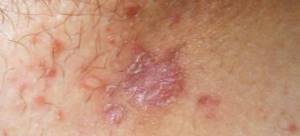
Tests (smears) for sexually transmitted diseases in women
The most common method of testing for sexually transmitted diseases is smear testing.
There are several types of analysis.
- Simple microscopy. This is one of the elementary tests in which discharge from the genital tract, urethra, and rectal discharge are taken for examination. The examination has a simple technique; biomaterial can be collected by nursing staff. The smear applied to a glass slide is fixed, dried and examined under a microscope. This test can detect candidal infection, trichomoniasis, and gonorrhea. It also shows the general inflammatory process that is characteristic of many STIs.
- PCR. The method is the “gold standard” in diagnosing all types of sexually transmitted diseases. To perform this, biomaterial is collected by scraping from the mucous membrane of the cervical canal, anus, and the surface of the rash. The advantage of the PCR method is the ability to carry out analysis with a minimum amount of material. If the sample being studied contains only 2-3 of the desired bacteria, their genetic material will be multiplied many times over. Then, with the addition of a special reagent, identification of the pathogen becomes possible.
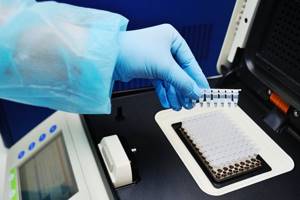
Treatment of sexually transmitted diseases in women
The treatment regimen for each specific disease is always individual.
You should not take the same medications that, for example, were prescribed to your sexual partner.
Even if the pathogens in the analyzes are identical.
When prescribing treatment, the doctor takes into account your anthropometric data, the presence of concomitant somatic diseases, and expected side effects.
Let's consider the main groups of drugs that are prescribed in the presence of sexually transmitted diseases.
- Antibiotics are the most commonly prescribed medications. They are prescribed for all bacterial infections. Drugs from the group of penicillins, macrolides, fluoroquinolones, etc. can be used. 1 or 2 antibiotics are prescribed depending on the clinical situation. Treatment duration is from 7 days to 3 weeks.
- Antiviral drugs - prescribed for HPV, herpes infection, condylomatosis. Often, even in cases of bacterial pathology, they are included in treatment regimens, since these drugs can enhance local immunity. Medicines are most often prescribed in rectal or vaginal suppositories, as well as intravenously.
- Antimycotic drugs are given for fungal infections, as well as to eliminate complications of antibacterial therapy (thrush, oral candidiasis, intestinal dysbiosis).
- Antimicrobial agents (metronidazole, ornidazole) are prescribed for trichomoniasis, in treatment regimens for bacterial infections.
- Acaricidal drugs, benzyl benzoate, sulfur ointment, and products with perimeter are used to treat parasitic diseases.
- Hepatoprotectors, gastroprotectors are tableted drugs used to protect the liver, intestines and stomach when taking long-term antibiotic regimens.
- Biological products for restoring the microflora of the vagina and intestines.
- Local treatment for sexually transmitted diseases in women is prescribed in the form of vaginal suppositories containing antibiotic, antiseptic, antimicrobial, antimycotic components or various combinations thereof. Local treatment acts as an auxiliary one. Also, to mechanically wash out bacteria, vaginal douching and baths, including those with medicinal herbs, can be recommended.
Medicine in the Middle Ages: fasting and prayer
At the end of the fourth century, the Great Roman Empire was divided into Western and Eastern. The western part quickly declined due to many factors, including epidemics, the invasion of the Goths, the spread of the Christian religion, etc. This marked the beginning of the Dark Ages, when science, art, economics and medicine declined. In medicine, Galen's ideas prevailed without much development, since people believed that God was in charge of man's destiny - and that means doctors were not needed, prayers and miracles were enough.
The medieval worldview recommended asceticism, chastity and purity as moral and religious duties. Marriage has become a sacred institution, necessary only for reproduction. These ideas coexisted with superstitions, astrology and very strange methods of treatment.
In the East, in the Byzantine Empire, outstanding doctors continued to work.
They wrote books, introduced new medical concepts (for example, “eczema”) and described diseases, including sexually transmitted diseases. Surgery and gynecology continued to develop, and treatment methods were “improved.” Thus, in one of the books it was proposed to treat ulcers on the genitals with aloe and pine bark.
The Byzantine Empire is believed to have preserved the medical knowledge of the ancient world until the arrival of Arab culture.
Treatment times for sexually transmitted diseases and side effects
The duration of the treatment course can vary widely.
For example, for trichomoniasis there is even a one-day treatment regimen.
Whereas treatment of viral pathology can take 6 months or more.
Side effects are determined by the specific drug.
Most often, allergic reactions (rash, Quincke's edema), dyspeptic manifestations (vomiting, nausea, changes in stool), changes in nervous activity (headaches, sleep disturbances), etc. are observed.
Prevention of sexually transmitted diseases in women
All measures aimed at preventing the occurrence of sexually transmitted diseases are divided into primary and secondary.
The primary ones come down to sexual culture (having a regular sexual partner) and the use of barrier methods of contraception.
Secondary prevention is aimed at preventing possible infection.
Drug prevention of sexually transmitted diseases in women comes down to taking medications prescribed by a venereologist.

- Bicillin is one of the oldest antibiotics, effectively used in the prevention of syphilis in persons who have had sexual contact with a carrier of a syphilitic infection. It is used in the form of intramuscular injections.
- Metrogyl is a solution containing metronidazole. Used for antiprotozoal and antimicrobial prophylaxis in the form of an intravenous drip. More often prescribed for the preventive treatment of trichomoniasis.
- Retarpen is an injection powder containing benzathine benzylpenicillin. Used to prevent syphilitic infection.
- Ceftriaxone is a broad-spectrum antibiotic that can be used to prevent the development of most bacterial infections.
- Azithromycin, erythromycin - tablets for the prevention of sexually transmitted diseases in women. Can be effective against chlamydia, mycoplasma, ureaplasma, etc.
- Suppositories for the prevention of sexually transmitted diseases in women can only be used as an aid and in cases where infection is unlikely. They can protect against candida infections and some bacteria. Suppositories containing chlorhexidine (Hexicon), metronidazole (Metromicon), iodine (Betadine), etc. are placed.
Formation of the first medical schools: bloodletting and vinegar
In the sixth and seventh centuries, the so-called “monastic medicine” began to appear - monks for a long time were the only educated people. Manuscripts were collected in monasteries and medicinal plants were grown. In Europe of the Middle Ages, venereal diseases were very common due to the disorder of life, war, prostitution and the existence of brothels. It has become obvious that some infections are sexually transmitted, as evidenced by laws regulating the exclusion of women with genital inflammation from brothels.
"Venereal diseases", 1496
The first medical schools began to develop, the most important of which was the school in Salerno. Interestingly, several women worked there, among whom the most famous was Trotula, who described “women’s diseases.” And the first to link sexual intercourse with the possibility of infection was Abbess Hildegard of Bingen. In her book, she described a curable form of “lustful men” leprosy—some scientists believed it was syphilis.
New methods of treating venereal diseases emerged, including post-coital rinsing with cold water or vinegar, mercury ointments, leeches, bloodletting, baths, emetics and urethral irrigation.
Diagnosis and treatment of sexually transmitted diseases in women during pregnancy
Screening for STIs is included in all protocols for the management of pregnant women.
A number of tests are taken twice (syphilis, HIV), and all viral and bacterial infections are taken once when registering.

Treatment is carried out at any time at which the diagnosis was made.
Today, there are a number of antibiotics that are approved for use in pregnant women and do not harm the unborn baby.











